本文主要结合15721和clickhouse源码来聊聊向量化,正好我最近也在用Eigen做算子加速,了解下还是有好处的。
提示编译器
提示编译器而不是复杂化简单的代码
什么时候使用汇编,什么时候使用SIMD?下面有几个基本原则:
- 如果编译器能知道怎么优化是最好的(绝大多数情况下),那么不要复杂化代码。
- 编译器的优势是聪明,但你的优势是知道的多,因此提示编译器而不是手写汇编/SIMD。
- 99%的情况下不要使用SIMD,如果你发现无法成功提示编译器,并且这里的性能_真的_很重要,那么可以使用SIMD,但是要注意跨平台的问题,并测试你的代码真的超过了-O3下的编译器(因为流水线和CPU性能问题,性能可能并没有提高)。
- 不要使用汇编,除非你找到了SIMD库的问题(https://www.intel.com/content/www/us/en/docs/intrinsics-guide/index.html)
Clickhouse目前的代码量超过百万行,使用SIMD的地方也只有七个文件,只有极少的处理跨平台的汇编代码:

编译器能进行的优化
下面就说一下最常用的Release(O2)和O3级别编译器采取的优化,这些优化都是可以被关闭的。
O2
-fauto-inc-dec:对自增和自减操作进行优化,将其转换为更高效的指令序列。
-fbranch-count-reg:使用寄存器来统计分支指令的执行次数,用于分支预测优化。
-fcombine-stack-adjustments:合并连续的堆栈调整操作,以减少不必要的指令。
-fcompare-elim:消除不必要的比较操作,减少程序的运行时间。
-fcprop-registers:通过寄存器传播常量的值,以减少内存访问。
-fdce:删除未使用的代码。
-fdefer-pop:推迟对堆栈的调整操作,以减少指令的数量。
-fdelayed-branch:推迟分支指令的执行,以减少流水线的停顿。
-fdse:进行死代码消除优化,删除不可达的代码。
-fforward-propagate:进行常量传播优化,将常量传播到使用该常量的代码中。
-fguess-branch-probability:根据先前的执行信息猜测分支指令的概率,以优化分支预测。
-fif-conversion:对if语句进行优化,将条件表达式转换为更简单的形式。
-fif-conversion2:进行更复杂的if语句优化,包括通过更改条件的计算顺序来提高性能。
-finline-functions-called-once:对只被调用一次的函数进行内联展开。
-fipa-modref:进行模块间引用分析优化,减少不必要的内存操作。
-fipa-profile:根据程序的执行信息进行优化。
-fipa-pure-const:将纯函数和常量传播进行优化。
-fipa-reference:进行引用分析优化,减少不必要的内存操作。
-fipa-reference-addressable:进行可寻址引用分析优化,减少不必要的内存操作。
-fmerge-constants:合并重复的常量,以减少内存的使用。
-fmove-loop-invariants:将循环不变式移动到循环外部,以减少循环迭代次数。
-fomit-frame-pointer:优化代码以减少堆栈帧的使用。
-freorder-blocks:重新排序基本块以优化执行路径。
-fshrink-wrap:将变量的生命周期范围缩小到最小,以减少内存的使用。
-fshrink-wrap-separate:在函数中单独进行缩小作用域的操作。
-fsplit-wide-types:将宽类型的变量分割为多个较窄的变量,以减少内存的使用。
-fssa-backprop:通过SSA(静态单赋值)形式的数据流分析来优化代码。
-fssa-phiopt:通过SSA形式的Phi函数优化来优化代码。
-ftree-bit-ccp:进行位级的常量传播优化。
-ftree-ccp:进行常量传播优化。
-ftree-ch:进行复杂表达式优化。
-ftree-coalesce-vars:合并变量来减少内存的使用。
-ftree-copy-prop:进行复制传播优化。
-ftree-dce:进行死代码消除优化。
-ftree-dominator-opts:进行支配关系优化。
-ftree-dse:进行死存储消除优化。
-ftree-forwprop:进行常量传播和复制传播的优化。
-ftree-fre:进行冗余表达式消除优化。
-ftree-phiprop:对Phi函数进行优化。
-ftree-pta:进行指针分析优化。
-ftree-scev-cprop:进行简单标量表达式和常量传播优化。
-ftree-sink:将表达式移动到循环外部,以减少循环迭代次数。
-ftree-slsr:进行简单局部标量替换优化。
-ftree-sra:进行标量寄存器分配优化。
-ftree-ter:进行三元表达式优化。
-falign-functions:强制函数在内存中按指定的对齐方式对齐。
-falign-jumps:强制跳转指令在内存中按指定的对齐方式对齐。
-falign-labels:强制标签在内存中按指定的对齐方式对齐。
-falign-loops:强制循环开始地址在内存中按指定的对齐方式对齐。
-fcaller-saves:在函数调用时,保存调用者寄存器的值,以便被调用函数可以修改这些寄存器的值。
-fcode-hoisting:将可能的计算移动到循环外部,以减少循环迭代次数。
-fcrossjumping:在不同的控制流路径中查找重复的代码块,并将其合并为一个共享的代码块。
-fcse-follow-jumps:在跳转指令后面的代码中进行公共子表达式消除。
-fcse-skip-blocks:跳过指定数量的基本块,以提高公共子表达式消除的效率。
-fdelete-null-pointer-checks:删除空指针检查,以提高代码的执行速度。
-fdevirtualize:对虚函数调用进行优化,将虚函数调用转化为直接调用。
-fdevirtualize-speculatively:假设虚函数调用的目标是唯一的,并将其转化为直接调用。
-fexpensive-optimizations:进行一些代价较高的优化,可能会增加编译时间。
-ffinite-loops:假设循环最多执行有限次数,进行一些循环优化。
-fgcse:进行全局公共子表达式消除,删除重复计算的代码。
-fgcse-lm:对循环进行公共子表达式消除,删除循环内重复计算的代码。
-fhoist-adjacent-loads:将相邻的加载指令移动到循环外部,以减少循环迭代次数。
-finline-functions:对函数进行内联展开,将函数调用处替换为函数体。
-finline-small-functions:对小函数进行内联展开。
-findirect-inlining:对间接函数调用进行内联展开。
-fipa-bit-cp:进行位级的常量传播优化。
-fipa-cp:进行常量传播优化。
-fipa-icf:进行间接代码优化,合并相似的间接调用。
-fipa-ra:进行间接寄存器分配优化。
-fipa-sra:进行间接寄存器分配优化,同时进行标量寄存器分配优化。
-fipa-vrp:进行值范围传播优化。
-fisolate-erroneous-paths-dereference:对错误路径上的指针解引用进行隔离。
-flra-remat:在循环中重新材料化值范围,以减少循环迭代次数。
-foptimize-sibling-calls:对兄弟函数调用进行优化。
-foptimize-strlen:对strlen函数进行优化。
-fpartial-inlining:对函数进行部分内联展开。
-fpeephole2:进行指令级别的优化。
-freorder-blocks-algorithm=stc:按指定的算法对基本块进行重新排序。
-freorder-blocks-and-partition:对基本块进行重新排序和分区,以提高指令级优化效果。
-freorder-functions:对函数进行重新排序,以提高指令级优化效果。
-frerun-cse-after-loop:在循环后重新运行公共子表达式消除。
-fschedule-insns:对指令进行调度以提高执行效率。
-fschedule-insns2 -fsched-interblock:对指令进行调度以提高执行效率。
-fstore-merging:合并存储操作,减少存储操作的数量。
-fstrict-aliasing:启用严格别名规则,优化代码对内存的访问。
-fthread-jumps:在多线程环境中,对线程间的跳转进行优化。
-ftree-builtin-call-dce:删除未使用的内建函数调用。
-ftree-pre:进行部分复写消除优化。
-ftree-switch-conversion:对switch语句进行转换优化。
-ftree-tail-merge:合并尾递归函数的调用。
-ftree-vrp:进行值范围传播优化。
O3
-fgcse-after-reload:在寄存器分配之后进行全局公共子表达式消除(GCSE)优化。
-fipa-cp-clone:通过复制函数来进行间接代码传播优化。
-floop-interchange:进行循环交换优化,改变循环的顺序。
-floop-unroll-and-jam:进行循环展开和循环合并的优化。
-fpeel-loops:将循环分解成多个部分,以减少循环迭代次数。
-fpredictive-commoning:通过提前计算和共享结果来进行预测性共享优化。
-fsplit-loops:将循环分割为多个部分,以便更好地利用指令级并行性。
-fsplit-paths:将控制流路径分割为多个部分,以便更好地利用指令级并行性。
-ftree-loop-distribution:将循环分布到多个线程或处理器上,以进行并行化处理。
-ftree-loop-vectorize:对循环进行向量化优化,以利用SIMD指令。
-ftree-partial-pre:进行局部部分预测优化,提前计算和共享部分结果。
-ftree-slp-vectorize:对循环进行超标量指令优化,将多条指令合并为一条指令。
-funswitch-loops:对循环进行开关优化,将循环展开成多个版本,通过开关语句来选择执行哪个版本。
-fvect-cost-model:使用向量化优化的成本模型进行优化。
-fvect-cost-model=dynamic:使用动态的向量化优化成本模型进行优化。
-fversion-loops-for-strides:对循环进行版本化优化,根据迭代步长来选择不同的版本进行执行。
直观感受一下
计算一个数字的二进制中有多少个 1
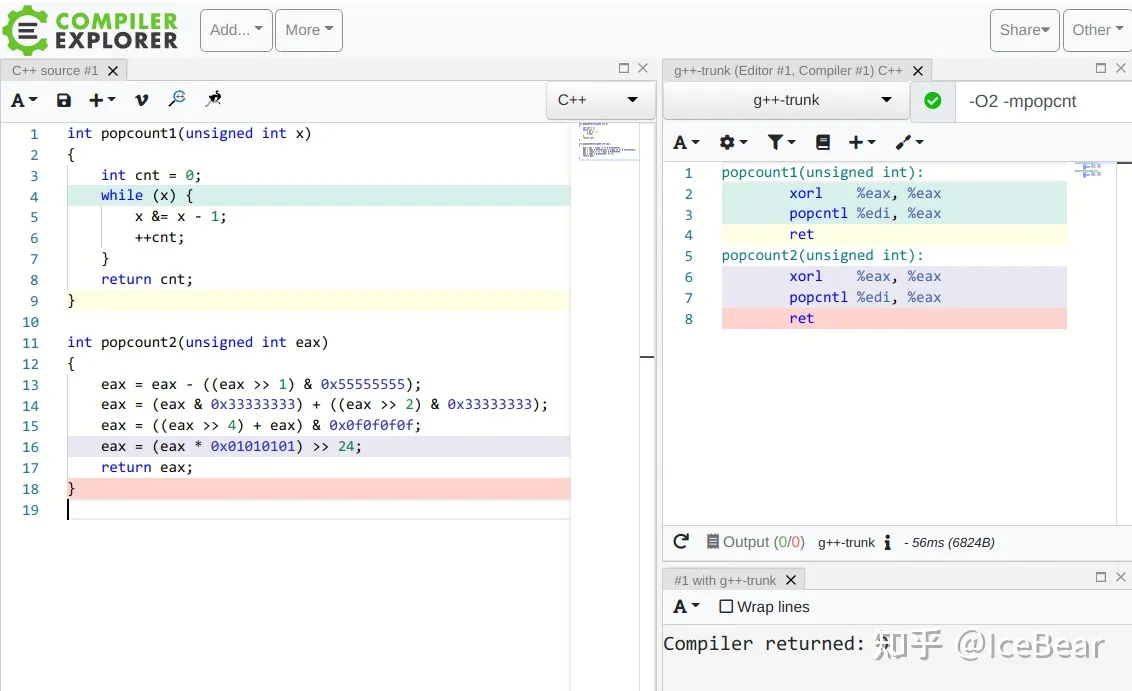
唯一的内存访问
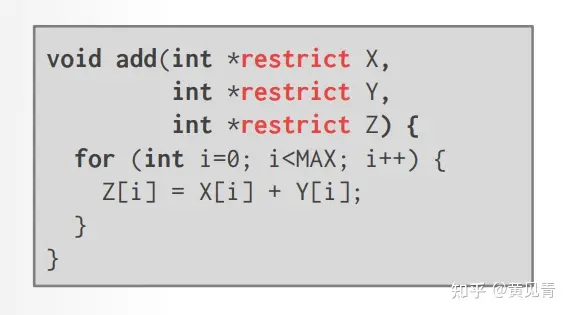
显式告诉编译器数组是内存中的不同位置
void f(int *a, int *b, int *c)
{
*a += *c;
*b += *c;
}
// f(int*, int*, int*):
// movl (%rdx), %eax
// addl %eax, (%rdi)
// movl (%rdx), %eax
// addl %eax, (%rsi)
// ret
void f(int * __restrict__ a, int* __restrict__ b, int* __restrict__ c)
{
*a += *c;
*b += *c;
}
// f(int*, int*, int*):
// movl (%rdx), %eax
// addl %eax, (%rdi)
// addl %eax, (%rsi)
// ret
显式告诉编译器忽略向量的循环依赖关系,作用和上面是一样的

除了可以用 __restrict 让编译器放心做 SIMD 优化外,还可以用 OpenMP 的这条指令来迫使编译器无视指针别名的问题,并启用 SIMD 优化。不过得给编译器打开 -fopenmp 这个选项。:


循环展开
循环展开现在编译器都会自动做了,有时候可能需要限制循环展开。
比如clickhouse里面的一段:
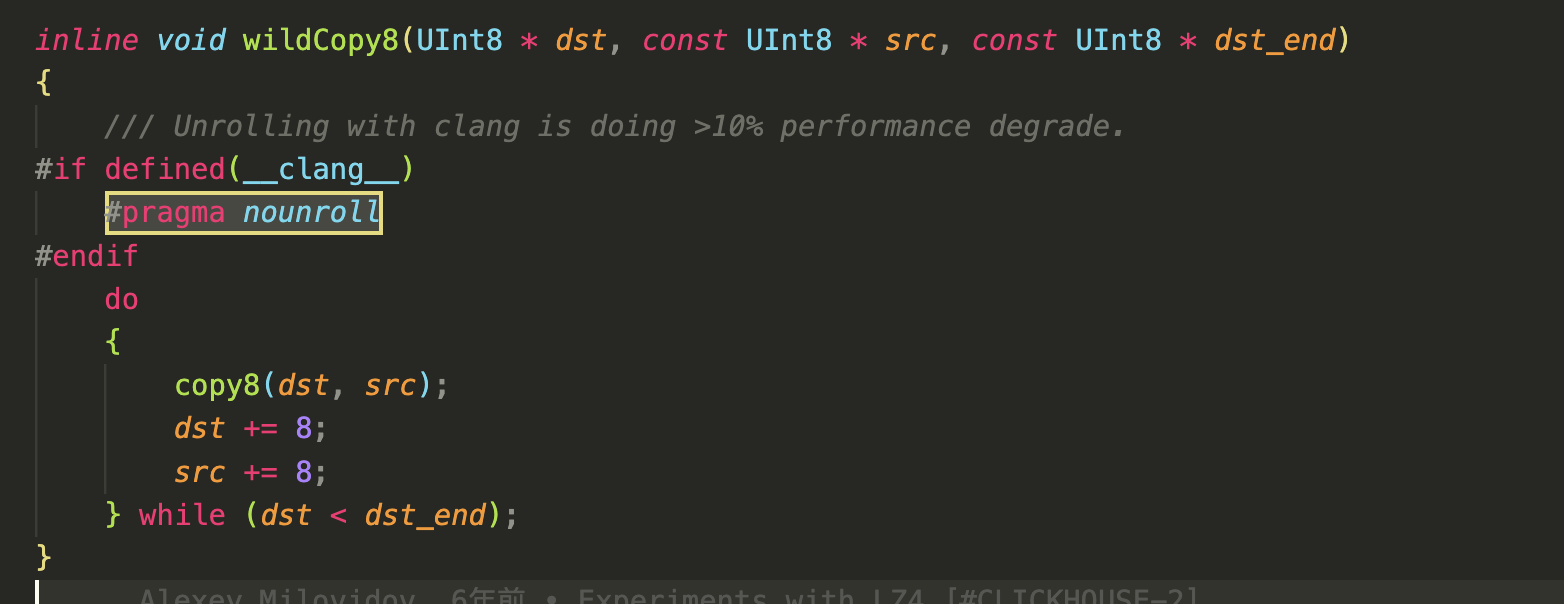
对小的循环体进行 unroll 可能是划算的,但最好不要 unroll 大的循环体,否则会造成指令缓存的压力反而变慢。
对齐
对齐的主要作用是使用SIMD向量化指令进行复杂的向量运算。
比如使用avx-512,将数据与64个字节对齐时可以通过_mm512_load_pd将数据直接加载到zmmm寄存器中,并在其上应用SIMD指令,然后通过_mm512 _stream_pd将其存储回。如果不进行大量的向量化计算,只会造成内存浪费。
相反,大多数情况下需要的是1字节填充来节省内存。
比如:
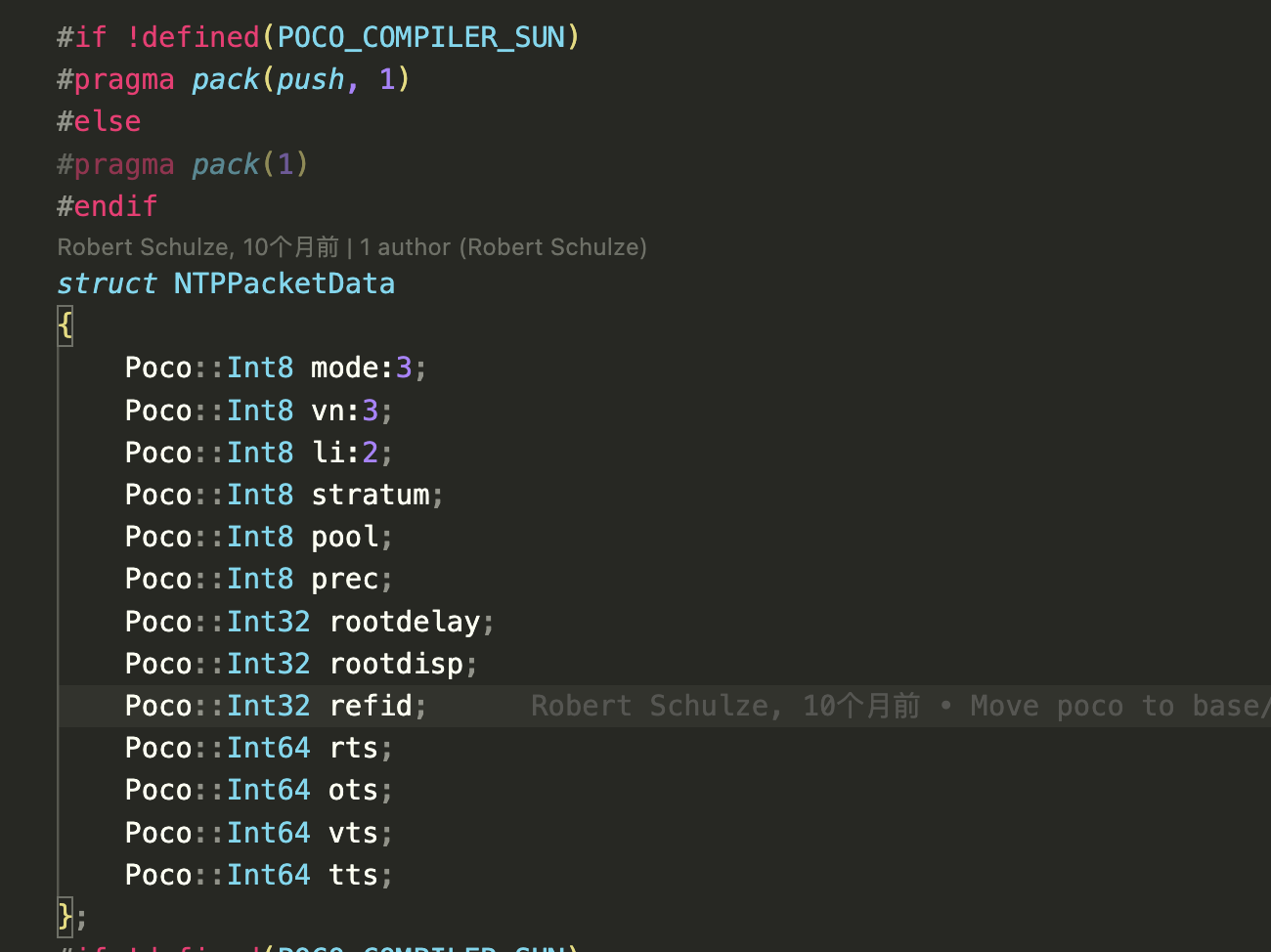
-ffast-math
https://stackoverflow.com/questions/7420665/what-does-gccs-ffast-math-actually-do
OLAP经常使用的SIMD操作
所谓的SIMD,就是用MMX指令集(64位SIMD寄存器)或者SSE/AVX/AVX512指令集(128位SIMD寄存器),做数据的并行化处理。
- 遮罩 Masking
- 排列
- 选择性加载 / 存储
- 压缩 / 扩展
- 选择性聚集 / 散开
遮罩

排列
对于每个通道,将索引向量中指定的偏移量处的输入向量的值复制到目标向量中。在 AVX-512 之前,数据库管理系统必须将数据从 SIMD 寄存器写入内存,然后再写回 SIMD 寄存器。而 AVX-512 指令集引入了新的 PERMUTE 操作,可以直接在 SIMD 寄存器内部完成元素重排,大大提高了性能。

blend:
在SIMD(Single Instruction, Multiple Data)编程中,Blend(混合)是一种操作,用于将两个向量按照指定的规则进行混合。混合操作通常是将两个向量的对应元素进行混合,生成一个新的向量。
选择性加载 / 存储
选择性加载从内存中读取满足特定条件的数据元素,而选择性存储将数据元素写回内存
压缩 / 扩展
用于减少数据存储需求和提高内存访问效率。
压缩操作将数据集中的冗余信息删除,减小数据的存储空间。扩展操作则是压缩的逆过程,将压缩后的数据还原为原始格式
这两种指令
选择性聚集 / 散开
用于重组数据的技术。
选择性聚集从一个数据集中提取满足特定条件的元素,并将它们组合成一个新的、更紧凑的数据集。
选择性散开是选择性聚集的逆操作,它将数据集中的元素根据特定条件分散到一个更大的数据集中。
这两种操作可以提高数据处理效率,特别是在需要对数据进行过滤、合并或分组等操作时。
Make the most out of your SIMD investments: counter control flow divergence in compiled query pipelines
Clickhouse
clickhouse里面针对三种SIMD指令集进行了优化,分别是__SSE2__、AVX、NEON
#ifdef __SSE2__
#include <emmintrin.h>
#endif
#if USE_MULTITARGET_CODE
#include <immintrin.h>
#endif
#if defined(__aarch64__) && defined(__ARM_NEON)
# include <arm_neon.h>
# pragma clang diagnostic ignored "-Wreserved-identifier"
#endif
一共在代码里出现了17处。
所以,就算是OLAP这种CPU密集型的应用,手写SIMD也只是小部分情况。
memcpy
clickhouse重写了glibc的memcpy,这里作者提到:
- 如果用 -ftree-loop-distribute-patterns可能会导致编译器优化为自带的memcpy,而又会重新调用到重写的memcpy,导致递归调用,所以必须禁用掉。
- 用AVX512有两个问题:一个是降频,第二个是SSE切换AVX512的性能开销。
- 然后作者列了几个影响性能的因素:
- 预取指令,因为预取指令的大小不确定,而且在ARM中性能比较差,所以这里没有预取
- 对齐,这里使用不对齐的加载和对齐的存储
- 循环展开次数,这里固定为8次
- attribute((no_sanitize(“coverage”)))禁用行数统计
- 最后作者提到memcpy可能会在编译时被优化为循环赋值,使用**-fbuiltin-memcpy**
#include <stddef.h>
#include <emmintrin.h>
/** Custom memcpy implementation for ClickHouse.
* It has the following benefits over using glibc's implementation:
* 1. Avoiding dependency on specific version of glibc's symbol, like memcpy@@GLIBC_2.14 for portability.
* 2. Avoiding indirect call via PLT due to shared linking, that can be less efficient.
* 3. It's possible to include this header and call inline_memcpy directly for better inlining or interprocedural analysis.
* 4. Better results on our performance tests on current CPUs: up to 25% on some queries and up to 0.7%..1% in average across all queries.
*
* Writing our own memcpy is extremely difficult for the following reasons:
* 1. The optimal variant depends on the specific CPU model.
* 2. The optimal variant depends on the distribution of size arguments.
* 3. It depends on the number of threads copying data concurrently.
* 4. It also depends on how the calling code is using the copied data and how the different memcpy calls are related to each other.
* Due to vast range of scenarios it makes proper testing especially difficult.
* When writing our own memcpy there is a risk to overoptimize it
* on non-representative microbenchmarks while making real-world use cases actually worse.
*
* Most of the benchmarks for memcpy on the internet are wrong.
*
* Let's look at the details:
*
* For small size, the order of branches in code is important.
* There are variants with specific order of branches (like here or in glibc)
* or with jump table (in asm code see example from Cosmopolitan libc:
* https://github.com/jart/cosmopolitan/blob/de09bec215675e9b0beb722df89c6f794da74f3f/libc/nexgen32e/memcpy.S#L61)
* or with Duff device in C (see https://github.com/skywind3000/FastMemcpy/)
*
* It's also important how to copy uneven sizes.
* Almost every implementation, including this, is using two overlapping movs.
*
* It is important to disable -ftree-loop-distribute-patterns when compiling memcpy implementation,
* otherwise the compiler can replace internal loops to a call to memcpy that will lead to infinite recursion.
*
* For larger sizes it's important to choose the instructions used:
* - SSE or AVX or AVX-512;
* - rep movsb;
* Performance will depend on the size threshold, on the CPU model, on the "erms" flag
* ("Enhansed Rep MovS" - it indicates that performance of "rep movsb" is decent for large sizes)
* https://stackoverflow.com/questions/43343231/enhanced-rep-movsb-for-memcpy
*
* Using AVX-512 can be bad due to throttling.
* Using AVX can be bad if most code is using SSE due to switching penalty
* (it also depends on the usage of "vzeroupper" instruction).
* But in some cases AVX gives a win.
*
* It also depends on how many times the loop will be unrolled.
* We are unrolling the loop 8 times (by the number of available registers), but it not always the best.
*
* It also depends on the usage of aligned or unaligned loads/stores.
* We are using unaligned loads and aligned stores.
*
* It also depends on the usage of prefetch instructions. It makes sense on some Intel CPUs but can slow down performance on AMD.
* Setting up correct offset for prefetching is non-obvious.
*
* Non-temporary (cache bypassing) stores can be used for very large sizes (more than a half of L3 cache).
* But the exact threshold is unclear - when doing memcpy from multiple threads the optimal threshold can be lower,
* because L3 cache is shared (and L2 cache is partially shared).
*
* Very large size of memcpy typically indicates suboptimal (not cache friendly) algorithms in code or unrealistic scenarios,
* so we don't pay attention to using non-temporary stores.
*
* On recent Intel CPUs, the presence of "erms" makes "rep movsb" the most beneficial,
* even comparing to non-temporary aligned unrolled stores even with the most wide registers.
*
* memcpy can be written in asm, C or C++. The latter can also use inline asm.
* The asm implementation can be better to make sure that compiler won't make the code worse,
* to ensure the order of branches, the code layout, the usage of all required registers.
* But if it is located in separate translation unit, inlining will not be possible
* (inline asm can be used to overcome this limitation).
* Sometimes C or C++ code can be further optimized by compiler.
* For example, clang is capable replacing SSE intrinsics to AVX code if -mavx is used.
*
* Please note that compiler can replace plain code to memcpy and vice versa.
* - memcpy with compile-time known small size is replaced to simple instructions without a call to memcpy;
* it is controlled by -fbuiltin-memcpy and can be manually ensured by calling __builtin_memcpy.
* This is often used to implement unaligned load/store without undefined behaviour in C++.
* - a loop with copying bytes can be recognized and replaced by a call to memcpy;
* it is controlled by -ftree-loop-distribute-patterns.
* - also note that a loop with copying bytes can be unrolled, peeled and vectorized that will give you
* inline code somewhat similar to a decent implementation of memcpy.
*
* This description is up to date as of Mar 2021.
*
* How to test the memcpy implementation for performance:
* 1. Test on real production workload.
* 2. For synthetic test, see utils/memcpy-bench, but make sure you will do the best to exhaust the wide range of scenarios.
*
* TODO: Add self-tuning memcpy with bayesian bandits algorithm for large sizes.
* See https://habr.com/en/company/yandex/blog/457612/
*/
__attribute__((no_sanitize("coverage")))
static inline void * inline_memcpy(void * __restrict dst_, const void * __restrict src_, size_t size)
{
/// We will use pointer arithmetic, so char pointer will be used.
/// Note that __restrict makes sense (otherwise compiler will reload data from memory
/// instead of using the value of registers due to possible aliasing).
char * __restrict dst = reinterpret_cast<char * __restrict>(dst_);
const char * __restrict src = reinterpret_cast<const char * __restrict>(src_);
/// Standard memcpy returns the original value of dst. It is rarely used but we have to do it.
/// If you use memcpy with small but non-constant sizes, you can call inline_memcpy directly
/// for inlining and removing this single instruction.
void * ret = dst;
tail:
/// Small sizes and tails after the loop for large sizes.
/// The order of branches is important but in fact the optimal order depends on the distribution of sizes in your application.
/// This order of branches is from the disassembly of glibc's code.
/// We copy chunks of possibly uneven size with two overlapping movs.
/// Example: to copy 5 bytes [0, 1, 2, 3, 4] we will copy tail [1, 2, 3, 4] first and then head [0, 1, 2, 3].
// 不对齐的加载 两个重叠的movs
if (size <= 16)
{
if (size >= 8)
{
/// Chunks of 8..16 bytes.
__builtin_memcpy(dst + size - 8, src + size - 8, 8);
__builtin_memcpy(dst, src, 8);
}
else if (size >= 4)
{
/// Chunks of 4..7 bytes.
__builtin_memcpy(dst + size - 4, src + size - 4, 4);
__builtin_memcpy(dst, src, 4);
}
else if (size >= 2)
{
/// Chunks of 2..3 bytes.
__builtin_memcpy(dst + size - 2, src + size - 2, 2);
__builtin_memcpy(dst, src, 2);
}
else if (size >= 1)
{
/// A single byte.
*dst = *src;
}
/// No bytes remaining.
}
else
{
// 这里src和dst不可能同时128对齐,因此
/// Medium and large sizes.
if (size <= 128)
{
/// Medium size, not enough for full loop unrolling.
/// We will copy the last 16 bytes.
_mm_storeu_si128(reinterpret_cast<__m128i *>(dst + size - 16), _mm_loadu_si128(reinterpret_cast<const __m128i *>(src + size - 16)));
/// Then we will copy every 16 bytes from the beginning in a loop.
/// The last loop iteration will possibly overwrite some part of already copied last 16 bytes.
/// This is Ok, similar to the code for small sizes above.
while (size > 16)
{
_mm_storeu_si128(reinterpret_cast<__m128i *>(dst), _mm_loadu_si128(reinterpret_cast<const __m128i *>(src)));
dst += 16;
src += 16;
size -= 16;
}
}
else
{
/// Large size with fully unrolled loop.
/// Align destination to 16 bytes boundary.
size_t padding = (16 - (reinterpret_cast<size_t>(dst) & 15)) & 15;
/// If not aligned - we will copy first 16 bytes with unaligned stores.
if (padding > 0)
{
__m128i head = _mm_loadu_si128(reinterpret_cast<const __m128i*>(src));
_mm_storeu_si128(reinterpret_cast<__m128i*>(dst), head);
dst += padding;
src += padding;
size -= padding;
}
/// Aligned unrolled copy. We will use half of available SSE registers.
/// It's not possible to have both src and dst aligned.
/// So, we will use aligned stores and unaligned loads.
__m128i c0, c1, c2, c3, c4, c5, c6, c7;
while (size >= 128)
{
c0 = _mm_loadu_si128(reinterpret_cast<const __m128i*>(src) + 0);
c1 = _mm_loadu_si128(reinterpret_cast<const __m128i*>(src) + 1);
c2 = _mm_loadu_si128(reinterpret_cast<const __m128i*>(src) + 2);
c3 = _mm_loadu_si128(reinterpret_cast<const __m128i*>(src) + 3);
c4 = _mm_loadu_si128(reinterpret_cast<const __m128i*>(src) + 4);
c5 = _mm_loadu_si128(reinterpret_cast<const __m128i*>(src) + 5);
c6 = _mm_loadu_si128(reinterpret_cast<const __m128i*>(src) + 6);
c7 = _mm_loadu_si128(reinterpret_cast<const __m128i*>(src) + 7);
src += 128;
_mm_store_si128((reinterpret_cast<__m128i*>(dst) + 0), c0);
_mm_store_si128((reinterpret_cast<__m128i*>(dst) + 1), c1);
_mm_store_si128((reinterpret_cast<__m128i*>(dst) + 2), c2);
_mm_store_si128((reinterpret_cast<__m128i*>(dst) + 3), c3);
_mm_store_si128((reinterpret_cast<__m128i*>(dst) + 4), c4);
_mm_store_si128((reinterpret_cast<__m128i*>(dst) + 5), c5);
_mm_store_si128((reinterpret_cast<__m128i*>(dst) + 6), c6);
_mm_store_si128((reinterpret_cast<__m128i*>(dst) + 7), c7);
dst += 128;
size -= 128;
}
/// The latest remaining 0..127 bytes will be processed as usual.
goto tail;
}
}
return ret;
}
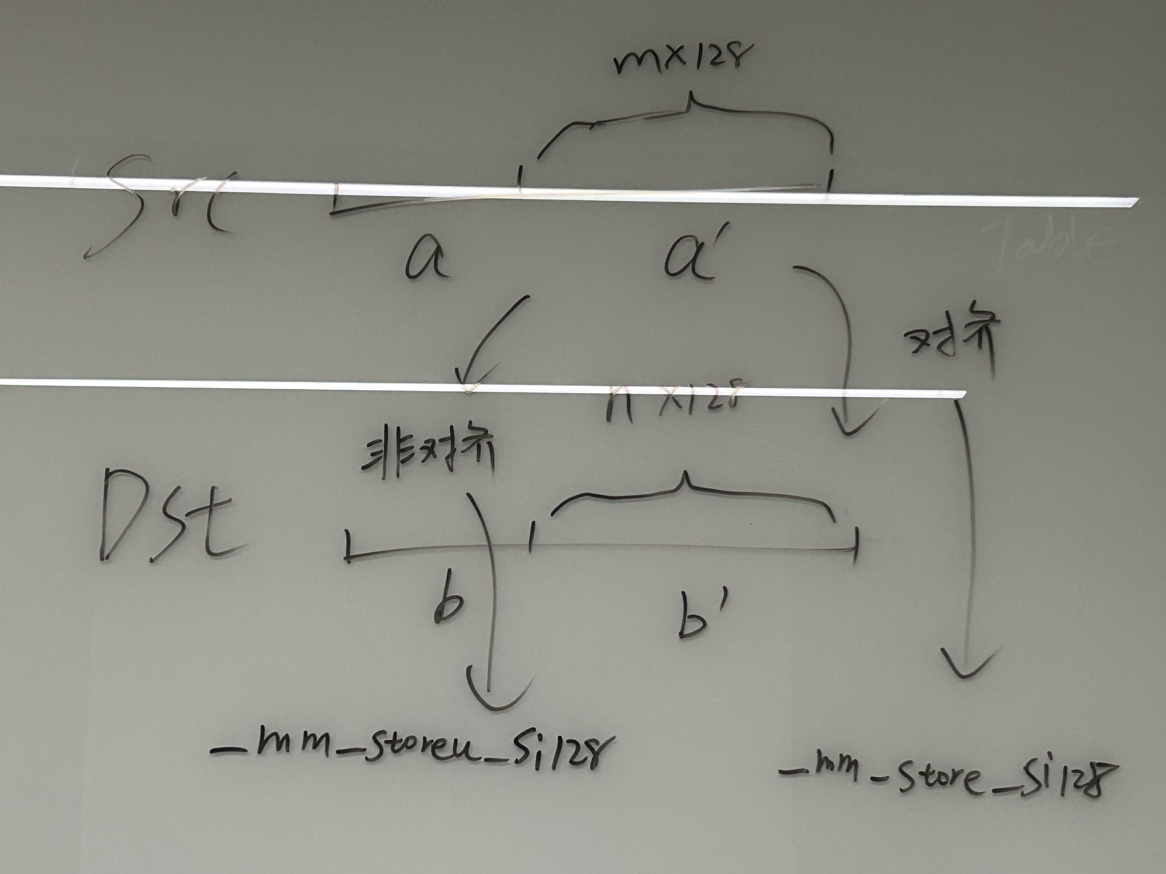
这里使用了一半的SSE寄存器(8个)来做,可能是考虑到32位平台上只有8个,而64位平台则可以进行展开。
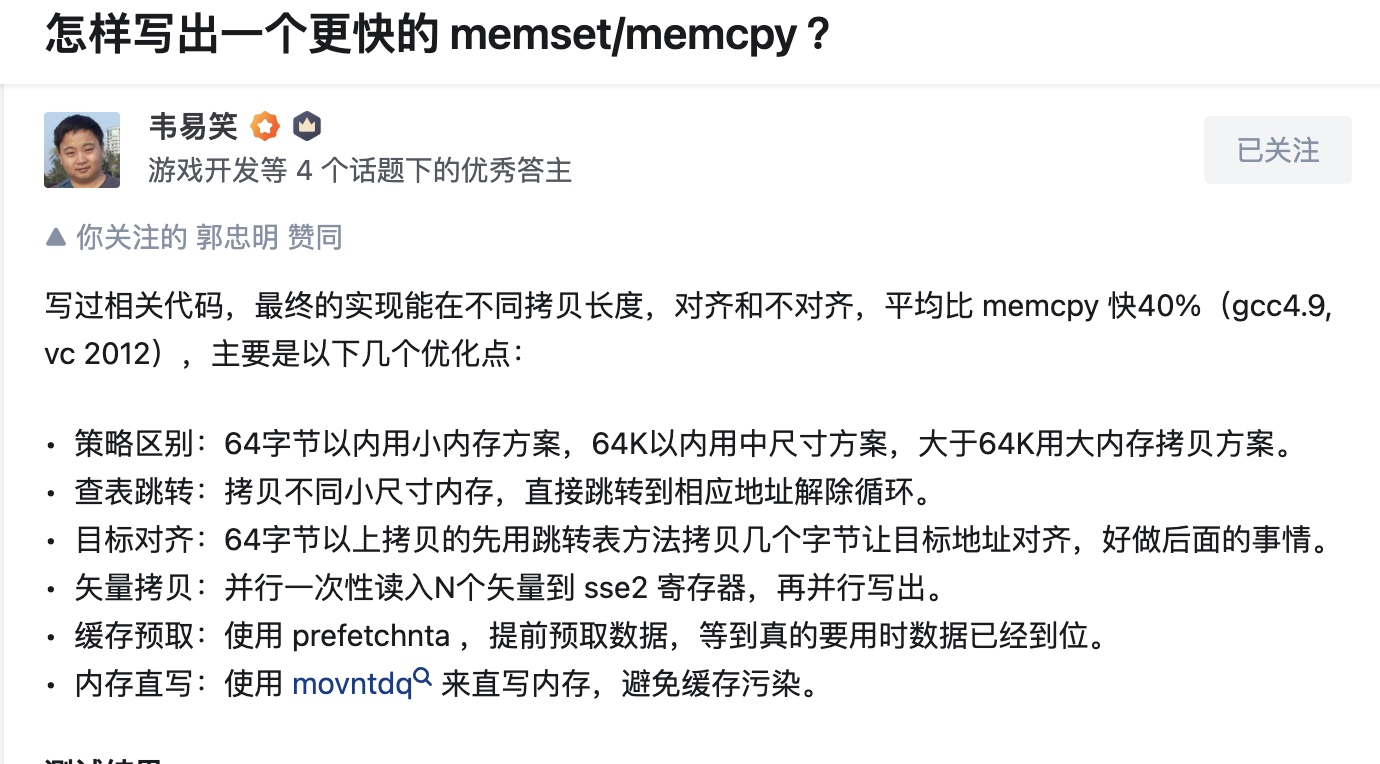
有些实现还会用预取指令,比如韦大佬写的FastMemcpy,clickhouse里面也有完整代码作为benchmark https://github.com/skywind3000/FastMemcpy/blob/master/FastMemcpy.h
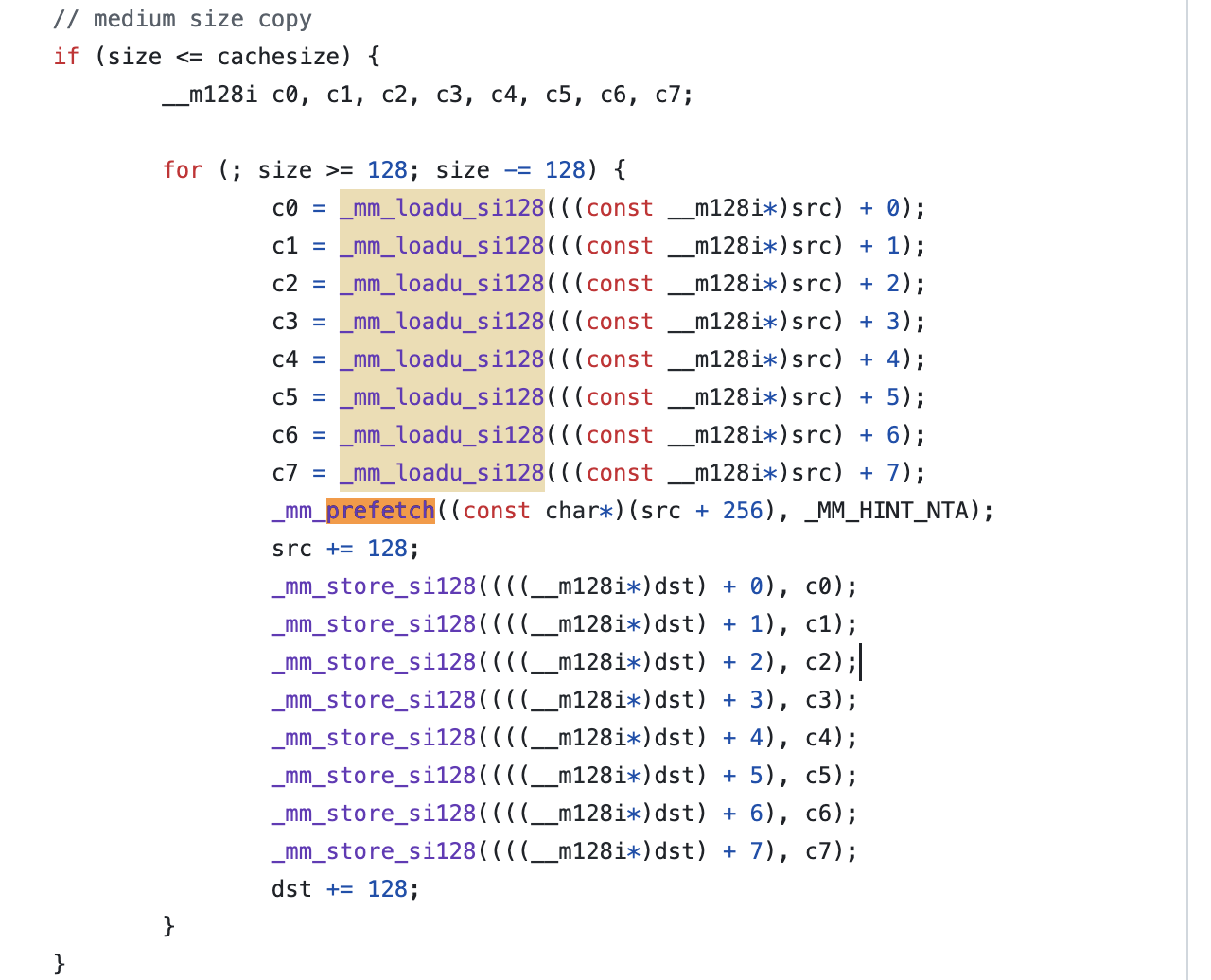
MergeTreeRangeReader
mergetree是clickhouse的列式存储结构,跟ORC很像,不过索引是分开存的(而且没有bloomfilter)。具体可以看https://bohutang.me/2020/06/26/clickhouse-and-friends-merge-tree-disk-layout/
这段代码是 ClickHouse 项目中的一段,它定义了一个名为 optimize 的方法,该方法在读取 ClickHouse 表的数据时优化读取的顺序和方式。具体来说,它在读取 ClickHouse 的 MergeTree 表时,对表中的数据进行预过滤,以减少读取的数据量,从而提高查询性能。https://github.com/ClickHouse/ClickHouse/blob/4279dd2bf11841d8f68bdea78f3d8668a2c4289b/src/Storages/MergeTree/MergeTreeRangeReader.cpp#L495
首先,它将 current_filter 和已有的 final_filter (如果存在)进行组合,创建一个新的过滤条件 filter,这个过滤条件将被应用在每个数据块的开头。
filter是一个PODArray
using Filter = PaddedPODArray<UInt8>;
使用向量化的代码在https://github.com/ClickHouse/ClickHouse/blob/4279dd2bf11841d8f68bdea78f3d8668a2c4289b/src/Storages/MergeTree/MergeTreeRangeReader.cpp#L730
这段代码的作用就是计算两个地址之间0位的大小。
使用godbolt分析下:
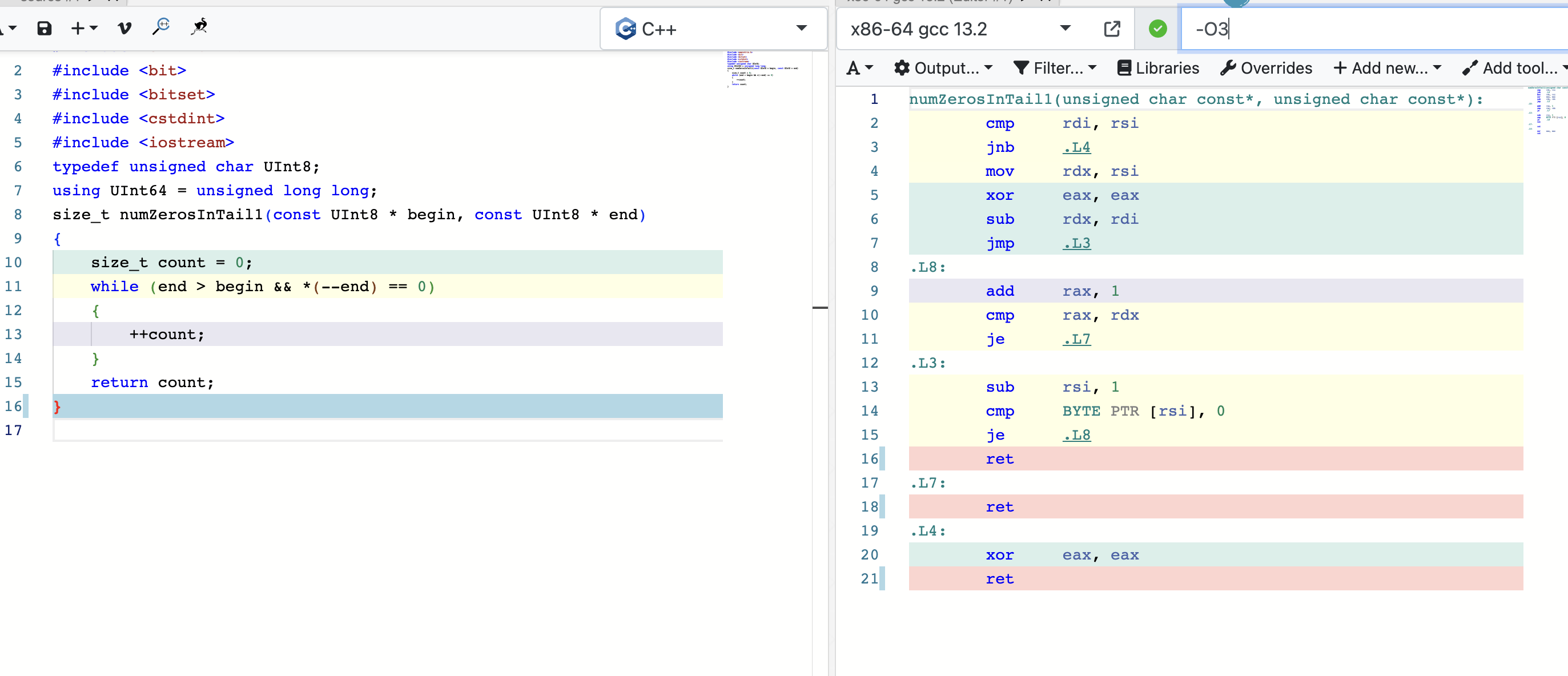
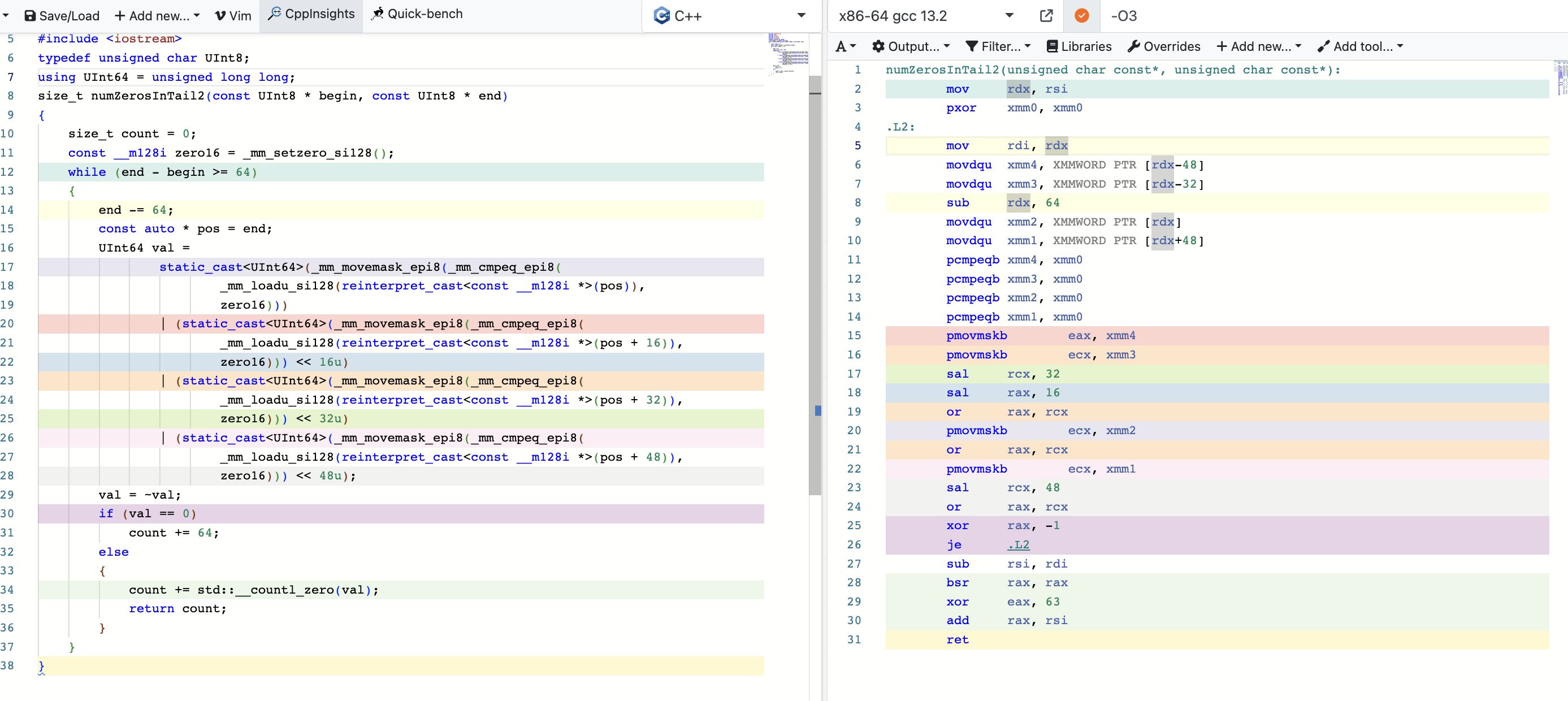
这里很明显,因为是逐位次比较,编译器不知道中间位数的多少,如果引入表跳转会导致缓存行失效的问题,所以编译器只使用普通寄存器进行。
但是在clickhouse场景下,这两个地址之间往往差距很大,所以这里加了分支。
处理流程如下所示,每次处理128*4位
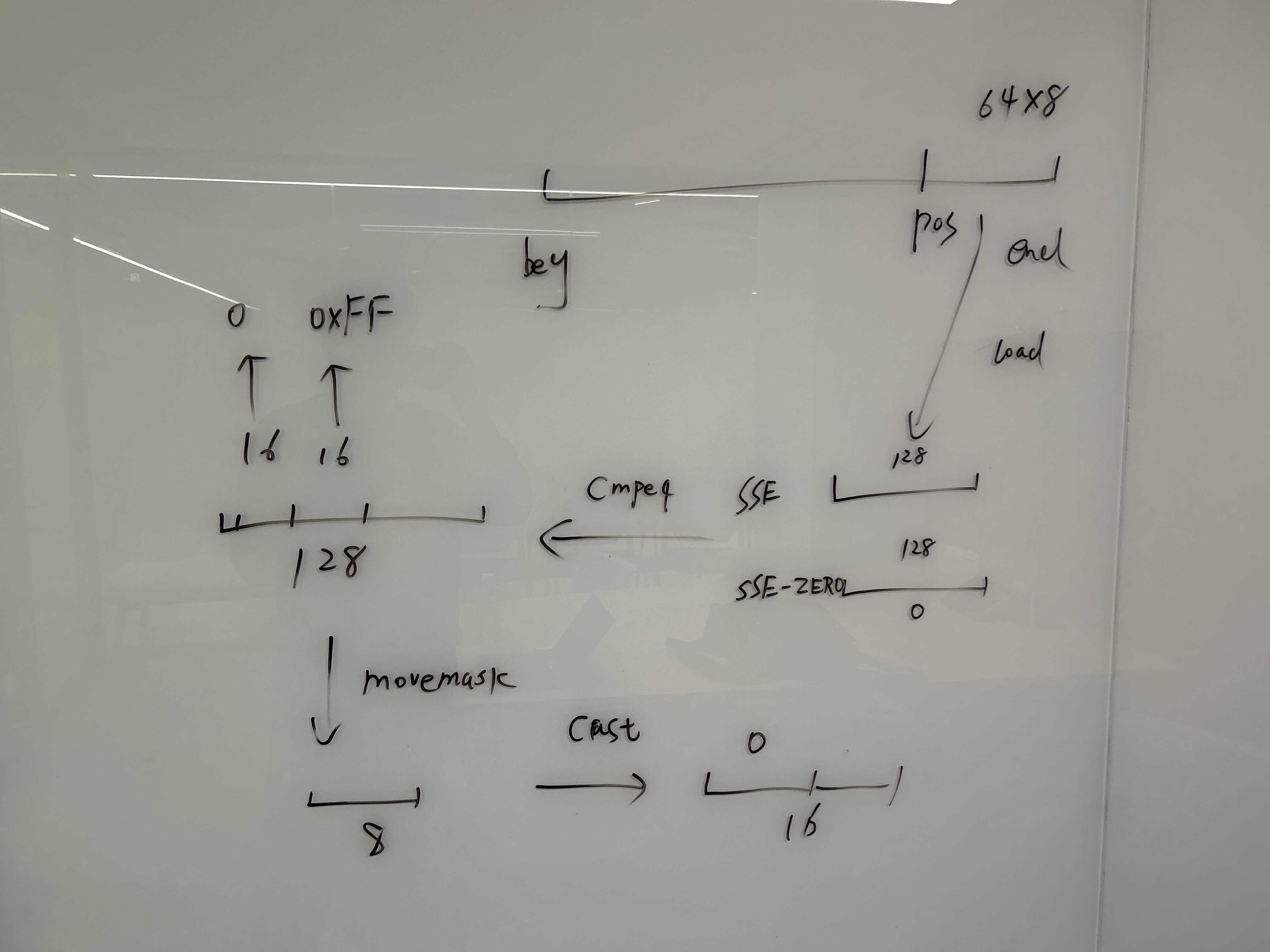
bytes64MaskToBits64Mask
https://github.com/ClickHouse/ClickHouse/blob/fc67d2c0e984098e492c1111c8b5e3c705a80e86/src/Columns/ColumnsCommon.h#L27C1-L27C1
这段代码就很简单,取64*64位的掩码到64位中。
/// Transform 64-byte mask to 64-bit mask
inline UInt64 bytes64MaskToBits64Mask(const UInt8 * bytes64)
{
#if defined(__AVX512F__) && defined(__AVX512BW__)
const __m512i vbytes = _mm512_loadu_si512(reinterpret_cast<const void *>(bytes64));
UInt64 res = _mm512_testn_epi8_mask(vbytes, vbytes);
#elif defined(__AVX__) && defined(__AVX2__)
const __m256i zero32 = _mm256_setzero_si256();
UInt64 res =
(static_cast<UInt64>(_mm256_movemask_epi8(_mm256_cmpeq_epi8(
_mm256_loadu_si256(reinterpret_cast<const __m256i *>(bytes64)), zero32))) & 0xffffffff)
| (static_cast<UInt64>(_mm256_movemask_epi8(_mm256_cmpeq_epi8(
_mm256_loadu_si256(reinterpret_cast<const __m256i *>(bytes64+32)), zero32))) << 32);
#elif defined(__SSE2__)
const __m128i zero16 = _mm_setzero_si128();
UInt64 res =
(static_cast<UInt64>(_mm_movemask_epi8(_mm_cmpeq_epi8(
_mm_loadu_si128(reinterpret_cast<const __m128i *>(bytes64)), zero16))) & 0xffff)
| ((static_cast<UInt64>(_mm_movemask_epi8(_mm_cmpeq_epi8(
_mm_loadu_si128(reinterpret_cast<const __m128i *>(bytes64 + 16)), zero16))) << 16) & 0xffff0000)
| ((static_cast<UInt64>(_mm_movemask_epi8(_mm_cmpeq_epi8(
_mm_loadu_si128(reinterpret_cast<const __m128i *>(bytes64 + 32)), zero16))) << 32) & 0xffff00000000)
| ((static_cast<UInt64>(_mm_movemask_epi8(_mm_cmpeq_epi8(
_mm_loadu_si128(reinterpret_cast<const __m128i *>(bytes64 + 48)), zero16))) << 48) & 0xffff000000000000);
#elif defined(__aarch64__) && defined(__ARM_NEON)
const uint8x16_t bitmask = {0x01, 0x02, 0x4, 0x8, 0x10, 0x20, 0x40, 0x80, 0x01, 0x02, 0x4, 0x8, 0x10, 0x20, 0x40, 0x80};
const auto * src = reinterpret_cast<const unsigned char *>(bytes64);
const uint8x16_t p0 = vceqzq_u8(vld1q_u8(src));
const uint8x16_t p1 = vceqzq_u8(vld1q_u8(src + 16));
const uint8x16_t p2 = vceqzq_u8(vld1q_u8(src + 32));
const uint8x16_t p3 = vceqzq_u8(vld1q_u8(src + 48));
uint8x16_t t0 = vandq_u8(p0, bitmask);
uint8x16_t t1 = vandq_u8(p1, bitmask);
uint8x16_t t2 = vandq_u8(p2, bitmask);
uint8x16_t t3 = vandq_u8(p3, bitmask);
uint8x16_t sum0 = vpaddq_u8(t0, t1);
uint8x16_t sum1 = vpaddq_u8(t2, t3);
sum0 = vpaddq_u8(sum0, sum1);
sum0 = vpaddq_u8(sum0, sum0);
UInt64 res = vgetq_lane_u64(vreinterpretq_u64_u8(sum0), 0);
#else
UInt64 res = 0;
for (size_t i = 0; i < 64; ++i)
res |= static_cast<UInt64>(0 == bytes64[i]) << i;
#endif
return ~res;
}
从这个里面我们可以看出来,编译器对SIMD的支持确实弱了点,也难怪clickhouse向量化有这么大优势。
这里无论我用STL容器还是指针,加什么编译选项,都无法优化为SIMD指令。

Hash64Long
这段代码在
https://github.com/ClickHouse/ClickHouse/blob/7f675ddf80b60445c769797b73353f32a6ff6ce5/contrib/libfarmhash/farmhash.cc#L796
这段代码实现了farmhashxo::Hash64算法,用于给定输入字符串生成64位哈希值的哈希函数。



